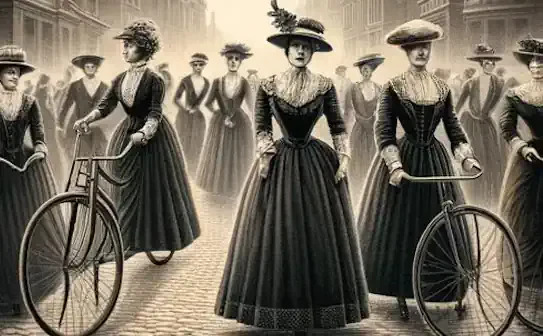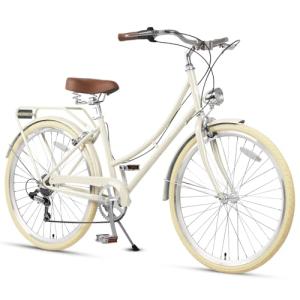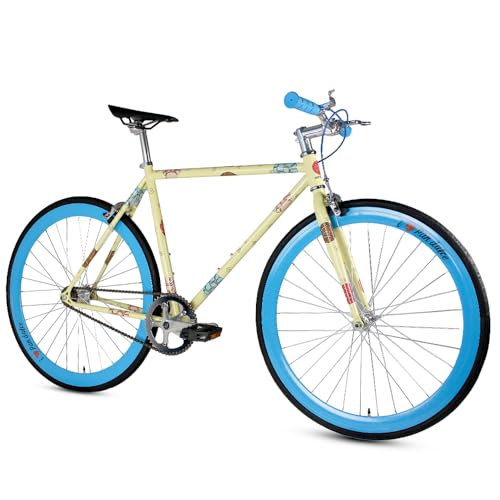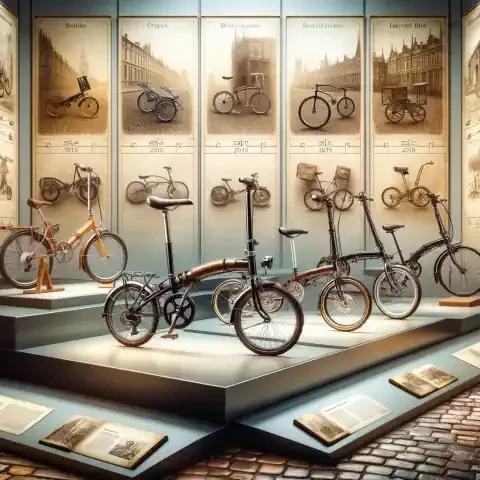Introduction
The bicycle is a simple yet revolutionary invention, captivating in its elegance and profound in its impact. Its humble beginnings belie the transformative role it would come to play in shaping transportation, society, and culture.
Importance: To truly understand the significance of bicycles, one must delve into their multifaceted influence. From redefining mobility to fostering societal shifts and cultural revolutions, bicycles have left an indelible mark on humanity's journey through time.
Overview: In this exploration, we embark on a journey through the annals of history, tracing the origins and evolution of bicycles. From their primitive precursors to the sleek and sophisticated models of the modern era, we uncover the threads that weave together the captivating tapestry of the bicycle's story. Through this lens, we gain insight into not only how bicycles came to be but also why they continue to hold such sway over the collective imagination.
Early Beginnings
The Precursors
Before the advent of the modern bicycle, humanity embarked on a quest for wheeled transportation. Archaeological evidence suggests that as early as 3500 BCE, civilizations in Mesopotamia and Asia were experimenting with wheeled carts and chariots. These rudimentary contraptions marked the first steps towards harnessing the power of wheels for travel and transportation.
The Draisine
Fast forward to the early 19th century, where the stage was set for a pivotal moment in transportation history. In 1817, Baron Karl Drais, a German inventor, unveiled his creation - the Draisine. Also known as the "running machine" or "hobby horse," this two-wheeled vehicle featured a wooden frame and handlebars for steering. Riders propelled themselves forward by pushing their feet against the ground, heralding a new era of human-powered transportation.
The Velocipede
The Draisine laid the groundwork for further innovation, paving the way for the development of the velocipede. In the mid-19th century, French blacksmith and carriage maker Pierre Michaux, along with his son Ernest, introduced a revolutionary enhancement - pedals. By attaching pedals to the front wheel of a Draisine-like vehicle, they created the first pedal-powered bicycle. This groundbreaking invention, also known as the "boneshaker" due to its uncomfortable ride over rough terrain, represented a significant leap forward in cycling technology and set the stage for the rapid evolution of bicycles in the years to come.
The Golden Age of Cycling
High-Wheeler Era
The late 19th century witnessed the rise of the high-wheeler, also known as the penny-farthing. These distinctive bicycles, characterized by their large front wheel and smaller rear wheel, became icons of the era. Despite their challenging design and precarious ride, high-wheelers gained popularity among daring cyclists seeking speed and adventure. With their lofty stature and bold presence, high-wheelers dominated the cycling landscape, capturing the imagination of enthusiasts around the world.
Safety Bicycle
However, the dominance of the high-wheeler was soon challenged by a revolutionary innovation - the safety bicycle. Invented in the 1880s, the safety bicycle featured two wheels of equal size, a chain-driven rear wheel, and a lower center of gravity, offering a more stable and comfortable ride compared to its high-wheel counterparts. This design breakthrough democratized cycling, making it accessible to a broader segment of the population, including women and less experienced riders. The safety bicycle quickly eclipsed the high-wheeler, becoming the preferred choice for cyclists worldwide and laying the foundation for modern bicycle design.
Cycling Craze
As the safety bicycle gained popularity, a cycling craze swept across the globe during the late 19th and early 20th centuries. Cycling clubs sprang up in cities and towns, organizing group rides, races, and social events. Cycling became not only a mode of transportation but also a popular pastime and sport enjoyed by people of all ages and backgrounds. From leisurely rides through the countryside to intense competitions on city streets, cycling captured the imagination of millions, fostering a sense of camaraderie and community among enthusiasts. The cycling craze left an indelible mark on the cultural landscape, influencing fashion, literature, and even the development of early automobiles. It was a golden age of cycling, marked by innovation, enthusiasm, and a shared passion for the freedom of the open road.
Bicycles and Social Change
Women's Liberation
The bicycle emerged as a powerful symbol of freedom and independence for women during the late 19th and early 20th centuries. Prior to the bicycle's widespread adoption, societal norms restricted women's mobility, confining them to domestic spaces and limiting their opportunities for exploration and self-expression. However, the advent of the safety bicycle shattered these constraints, providing women with a means of transportation that was affordable, efficient, and liberating. With the bicycle, women could venture beyond the confines of home and participate more fully in public life. Cycling offered them a sense of autonomy and agency, allowing them to break free from traditional gender roles and assert their right to mobility. In many ways, the bicycle became a catalyst for women's liberation, empowering them to challenge societal norms and pursue greater equality.
Transportation Revolution
The bicycle also played a pivotal role in revolutionizing urban transportation and shaping city planning. As cities grappled with the challenges of rapid industrialization and urbanization during the late 19th century, bicycles offered a practical solution to the growing problem of congestion and pollution. Unlike horse-drawn carriages and early automobiles, bicycles required minimal infrastructure and were well-suited to navigating crowded city streets. Cycling became an increasingly popular mode of transportation for urban residents, providing a fast, affordable, and environmentally friendly alternative to traditional forms of transit. In response to this burgeoning demand, cities began to invest in cycling infrastructure, building bike lanes, paths, and parking facilities to accommodate cyclists. The bicycle's influence on urban transportation planning was profound, laying the groundwork for future developments in sustainable mobility and shaping the way cities are designed and built.
Environmental Impact
Perhaps one of the most significant contributions of the bicycle to society is its environmental impact. Unlike motorized vehicles, bicycles produce no emissions and require no fossil fuels to operate. Cycling is a clean, green mode of transportation that reduces air and noise pollution, mitigates traffic congestion, and helps combat climate change. By choosing to cycle instead of driving, individuals can significantly reduce their carbon footprint and contribute to a more sustainable future. Furthermore, cycling promotes a healthier lifestyle, offering numerous physical and mental health benefits, which can lead to reduced healthcare costs and improved overall well-being for individuals and communities alike. As the world grapples with the urgent need to transition to more sustainable forms of transportation, the bicycle stands as a shining example of how simple, human-powered mobility can help build a greener, healthier planet for future generations.
Technological Advancements
Bicycle Innovations
Over the years, bicycles have undergone numerous technological advancements, revolutionizing their design and performance. One of the most significant innovations is the introduction of gears, which allow cyclists to adjust the resistance and speed of their pedaling. Gears enable riders to tackle varying terrain more efficiently, whether climbing steep hills or cruising on flat roads. Similarly, advancements in braking systems, such as the development of disc brakes, have improved safety and control, particularly in adverse weather conditions. Additionally, advancements in materials science have led to the use of lightweight yet durable materials, such as carbon fiber and titanium, which enhance the strength and performance of bicycles while reducing weight. These innovations continue to push the boundaries of bicycle design, making cycling more accessible, enjoyable, and versatile for riders of all skill levels.
Electric Bicycles
$1,299.00
4.45 out of 5 stars750W Electric Fat Tire Folding E-Bike for Adults
Experience the thrill of powered cycling with this 750W Electric Fat Tire Folding E-Bike designed for adults
Product information
Product Review Score
Product links
In recent years, electric bicycles, or e-bikes, have emerged as a game-changer in the world of cycling. E-bikes integrate electric motors and batteries into traditional bicycle frames, providing riders with an extra boost of power to assist with pedaling. This electric assistance enables cyclists to travel longer distances, tackle challenging terrain, and conquer hills with ease, making cycling more accessible to a wider audience, including older adults and individuals with mobility limitations. The growing popularity of e-bikes reflects a shifting paradigm in transportation, as more people recognize the benefits of electric-assist cycling for commuting, recreation, and everyday errands. As battery technology continues to improve and prices become more affordable, e-bikes are poised to become an integral part of the urban mobility landscape, offering a sustainable and efficient alternative to conventional forms of transportation.
Xspec 20" Folding Commuter Bike, Black
Unfold Your Commuting Potential with Xspec Folding Bike in Black!
Product information
$249.99
Product Review Score
4.72 out of 5 stars
211 reviewsProduct links
Future Trends
Looking ahead, the future of bicycle technology holds endless possibilities for innovation and evolution. Advancements in artificial intelligence and sensor technology could lead to the development of "smart" bicycles equipped with features such as automatic collision detection, adaptive cruise control, and real-time route optimization. Similarly, the integration of renewable energy sources, such as solar panels and regenerative braking systems, could further enhance the sustainability and efficiency of bicycles. Moreover, advances in 3D printing and customizable manufacturing processes may enable cyclists to personalize their bikes with tailored components and designs, catering to their unique preferences and riding styles. As society continues to prioritize sustainability, health, and efficiency, the bicycle is poised to remain at the forefront of transportation innovation, shaping the way we move and interact with our environment for generations to come.
Global Impact and Cultural Significance
Bicycles Around the World
The bicycle's influence extends far beyond national borders, transcending cultural differences and connecting people from diverse backgrounds around the globe. From bustling metropolises to remote rural villages, bicycles serve as a common mode of transportation, enabling individuals to navigate their surroundings with ease and efficiency. In developing countries, bicycles play a crucial role in providing access to education, healthcare, and economic opportunities, empowering communities to break the cycle of poverty and improve quality of life. Moreover, cycling has become a cherished cultural tradition in many parts of the world, with events like the Tour de France in France and the Keirin races in Japan capturing the hearts and imaginations of millions. Whether as a practical means of transportation or a beloved pastime, bicycles have left an indelible mark on cultures around the world, reflecting the universal human desire for freedom, mobility, and connection.
Bicycle Subcultures
Within the world of cycling, a rich tapestry of subcultures and communities has emerged, each with its own unique identity and ethos. Road racing enthusiasts push the limits of speed and endurance, competing in grueling competitions like the Tour de France and Giro d'Italia. Mountain biking aficionados embrace the thrill of off-road adventure, navigating rugged trails and conquering challenging terrain. BMX riders showcase their skills and creativity in urban skate parks, performing jaw-dropping tricks and stunts on two wheels. From fixed-gear aficionados to vintage bicycle collectors, the cycling community is as diverse and vibrant as the bicycles themselves, fostering a sense of camaraderie and belonging among enthusiasts of all stripes.
Representation in Art and Media
Throughout history, bicycles have been a ubiquitous presence in art, literature, film, and music, serving as symbols of freedom, nostalgia, and rebellion. In paintings and photographs, bicycles evoke a sense of wanderlust and exploration, capturing the essence of a bygone era or a moment of quiet reflection. In literature, bicycles feature prominently in coming-of-age stories and tales of adventure, serving as vehicles for self-discovery and personal growth. In film and television, bicycles are often used to convey a sense of whimsy and innocence, as seen in iconic scenes like Elliott flying across the moon on his bicycle in "E.T. the Extra-Terrestrial." In music, bicycles are celebrated in songs ranging from Queen's "Bicycle Race" to Pink Floyd's "Bike," each capturing the timeless allure of two wheels in motion. Across all forms of artistic expression, bicycles continue to captivate imaginations and inspire creativity, reminding us of the simple joy and boundless possibility of life on two wheels.
History of the Bicycle
Recap
The bicycle stands as a testament to human ingenuity and innovation, with a history rich in significance and impact. From its humble beginnings as a simple mode of transportation to its evolution into a global phenomenon, the bicycle has left an indelible mark on society, shaping transportation, culture, and even social norms. Throughout its history, the bicycle has served as a symbol of freedom, empowerment, and progress, connecting people from all walks of life and transcending cultural boundaries.
Reflection
As we reflect on the enduring legacy of the bicycle, we are reminded of its continued relevance in the modern world. In an age of increasing urbanization, environmental awareness, and technological innovation, the bicycle offers a sustainable and efficient solution to many of the challenges we face. From reducing traffic congestion and air pollution to promoting physical health and well-being, cycling has the power to transform communities and improve quality of life for millions around the world.
Therefore, let us embrace cycling as more than just a mode of transportation, but as a way of life. Let us rediscover the joy of exploring our surroundings on two wheels, whether through leisurely rides in the park, exhilarating mountain bike adventures, or spirited races with friends. Let us recognize the cultural significance of the bicycle and celebrate its role as a catalyst for social change and personal empowerment. And most importantly, let us commit to building a more sustainable and equitable future by prioritizing cycling as a viable and accessible mode of transportation for all. Together, we can pedal towards a brighter tomorrow, one revolution at a time.









